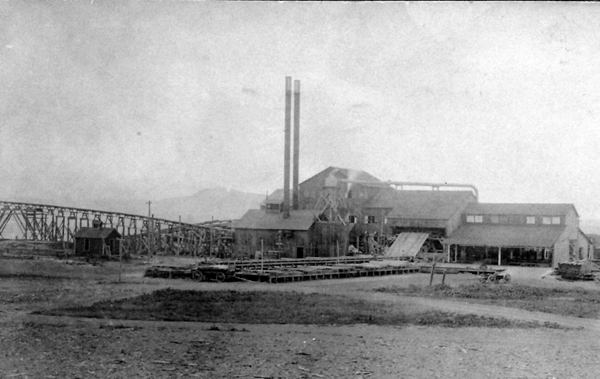
Big Horn Timber Company, approx. 1910.
In 1912, the Burlington System cancelled its contract to buy all the ties the Big Horn Timber Co. could produce. Nevertheless, the company
the company continued with extensions and repairs to the flume. The company provided timber requirements for Sheridan area coal mines. See
Sheridan Area Coal Mines. In the Spring of 1913, the operations were sold to Edwin H. Cuthbert, a real estate broker of
Atlantic City, New Jersoy. The purchase partially financed by the previous owners taking back paper and the remainder with outside financing.
The Company periodically announced that operation in the mountains would shorty resume. 1912, however, was the last
year that ties were floated down the flume from Woodrock. Operations in the mill, however, cont;inued using lumber that was on hand.
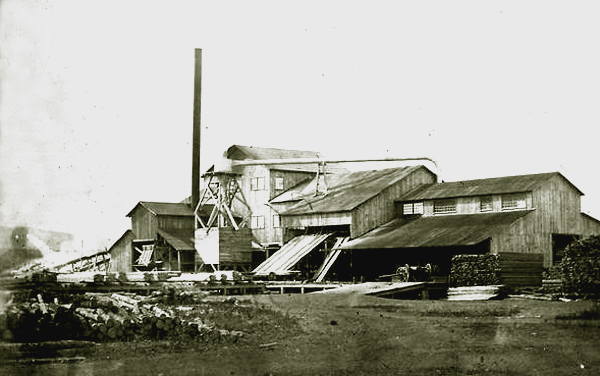
Big Horn Timber Company, approx. 1910.
On Sept. 9, 1913, a fire broke out in the south end of the plant. The cause of the fire was unknown. There were no operationns in the area
of the mill where the fire started which required the use of fire. The mill was completely consumed by the flames, with an exploding boiler adding to the
devastation.
The impact of the closure of the timber operations on Ranchester was devestating. Mayor Flook left town for Crawford, Nebraska. Judge Neeves ultimately moved back to
Dayton. Dr. Condit moved to Silverton where he had previously practiced. The business stock of R. E. Mills along with his automobile was foreclosed upon and auctioned off at public sale. Mills prior to
coming to Ranchester had been a railroad telegrapher. He bid in the
night shift at Oriva, Wyoming, 11 miles west of Gillette. Oriva consisted of a railroad crossing, a post office, and the railroad telegraph office.
As of 1939, it had a population of nine. The contents of his store was bid in by Tom Currie.
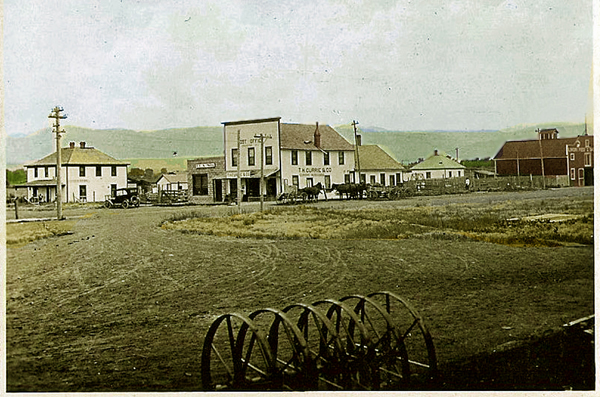
Ranchester, approx. 1918.
The two-story building is the T. H. Currie & Co. Mercantile owned by Tom Currie (Thomas Harvey Currie, 1866-1936). As previously noed, Currie
established the store in 1911. He previously served as postmaster in Monarch. After R. E. Mills left, Currie was appointed as postmaster in 1914. In 1925,
Currie brought in his brother-in-law, Arthur W. Black, who purchased the business. Currie also served on the local school board.
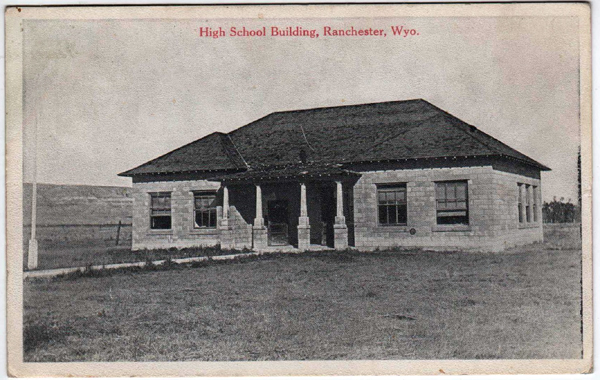
Ranchester High School, approx. 1920.
The electric lines were extended from the coal camps to the south in 1917. A party was held in celebration. Sheridan Electric presented a door prize of a
Hotpoint electirc Iron which was won by Mrs. Currie. The Town continued along with population approximating 200-250 until growth started in the 1970's. By 1980 it attained a population
of 657 and by 2010 attained 855.
The area has also been prominent in the raising of horses. As noted on a previous page,
Sheridan was the principal location for recruitment of horses for service in the
Boer War. Indeed, Dayton claims to have had the first rodeo.
At the south end of the Town of Ranchester is the site of the Connor Battle with the
Arapaho who were camped along side the Tongue River. On August 22, 1865, as the
Indians were breaking camp, Brigadier Patrick E. Connor (1820-1891) attacked driving the Indians up Wolf Creek. The Indians
counterattacked forcing Connor into a retreat. During the battle the Araphaho lost 64 men and
several hundred ponies. During the battle, Connor's men made no distinction between braves and
women and children. Prior to the battle the Arapaho were regarded as non-hostile. As a result,
the Arapaho participated with the Sioux and the Cheyenne at the Fetterman fight. Connor during the
Civil War was charged with protection of the overland mail route to California. He had
previously served in the Mexican War. He was discharged from service in 1866 with a rank of Brevet Major-General and
devoted himself to mining and anti-Mormon causes.
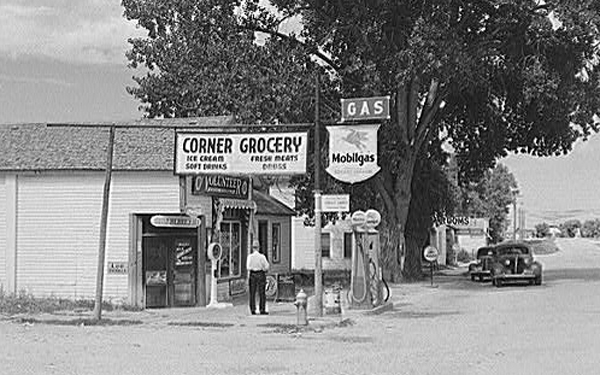
Dayton, 1941, Farm Security Administration photo by Marion Post Wolcott
Photographs taken by the Farm Security Administration always seemed to make things look
slightly more bleak than they were in fact. Dayton did consist of more than
a gas station and the Stockmen's Saloon pictured below. Note the fire hydrant indicating
the presence of a central water system for the town.
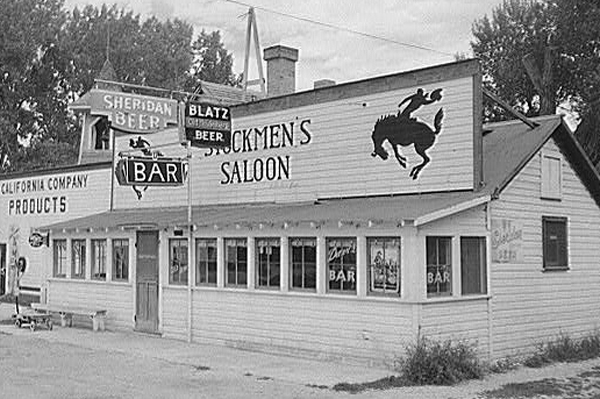
Stockman's Saloon, Dayton, August 1941, photo by
Marion Post Wolcott
The use of the "bucking horse" logo in Wyoming, as depicted on the saloon, dates back to
World War I when used by Wyoming troops. It is supposedly based on a real horse and rider, the
horse, "Steamboat," competed in rodeos between 1901 and 1914 when he became infected
with blood poisoning as a result of contact with a barbed wire fence during a thunderstorm.
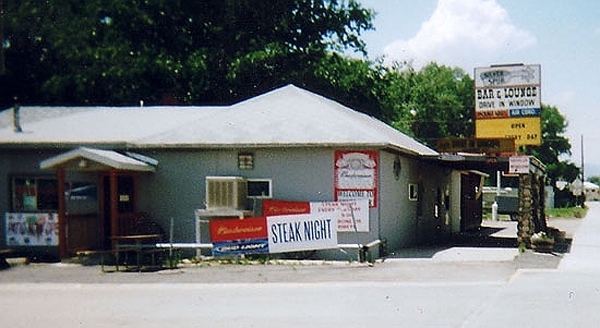
Silver Spur Saloon, Ranchester, June 2005, photo by
Geoff Dobson
Today few traces of the Tongue River Tie Flume remain. Much of the flume was removed by the Civilian Conservation Corps in the 1930's.
Portions which were easily accessbile were removed by settlers for lumber. Woodrock, the site of the last tie camp for the
Big Horn Timber Company is gone. The Post Office was located near the "Dead Swede" campground is presently located about
forty miles west of Dayton. Robert M. Granum, author of Hisory of the Tongue River Tie Flume; Sheridan County Library Foundation, 1991,
has suggested that the name of the campground arises out of an incident in the
last days of the Big Horn Timber Company. Two men were alleged left in the winter of 1912-1913 to tend to the Company property at Woodrock.
In the lonliness of the winter isolation, one went crazy and killed the other. the murderer fled and was never seen again.
Tie hacks were typically nicknamed "Swede." Thus, the name of the area. The allegation of the murder probably does not even rise to
the level of a myth. During the winter of 1912-1913, James Knight was in charge of the camp. The following spring he was alive and well.
Next Page: Cattle Trails.